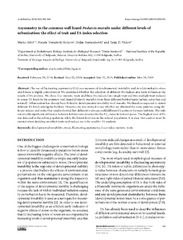Приказ основних података о документу
Asymmetry in the common wall lizard Podarcis muralis under different levels of urbanization: The effect of trait and FA index selection
| dc.creator | Mirč, Marko | |
| dc.creator | Tomašević-Kolarov, Nataša | |
| dc.creator | Stamenković, Srđan | |
| dc.creator | Vukov, Tanja | |
| dc.date.accessioned | 2020-01-10T11:33:12Z | |
| dc.date.available | 2020-01-10T11:33:12Z | |
| dc.date.issued | 2019 | |
| dc.identifier.issn | 0354-4664 | |
| dc.identifier.uri | http://www.doiserbia.nb.rs/Article.aspx?ID=0354-46641900033M | |
| dc.identifier.uri | http://www.serbiosoc.org.rs/arch/index.php/abs/article/view/4044 | |
| dc.identifier.uri | https://radar.ibiss.bg.ac.rs/handle/123456789/3569 | |
| dc.description.abstract | The use of fluctuating asymmetry (FA) as a measure of developmental instability and its relationship to stress and fitness is highly controversial. We examined whether the selection of different FA indices and traits influences the results of FA analysis. We chose four meristic traits and three FA indices (two single-trait and two multiple-trait indices) to assess FA levels in the common wall lizard (Podarcis muralis) from three different habitat types (urban, suburban and natural). Urbanization has already been linked to developmental instability in P. muralis. We therefore expected to detect different FA levels among the habitats. However, we also wanted to see whether we obtained the same patterns using different indices and traits. Our results showed that different traits can yield different FA patterns between habitats. The only statistically significant difference between habitats was detected for the FA2 index in femoral pores. The highest level of FA was detected in the urban population, while the lowest level was in the natural population. It is clear that caution must be exerted when deciding on which traits and indices are to be used for FA analysis | en |
| dc.relation | info:eu-repo/grantAgreement/MESTD/Basic Research (BR or ON)/173043/RS// | |
| dc.relation | info:eu-repo/grantAgreement/MESTD/Integrated and Interdisciplinary Research (IIR or III)/43001/RS// | |
| dc.rights | openAccess | |
| dc.rights.uri | https://creativecommons.org/licenses/by-nc-nd/4.0/ | |
| dc.source | Archives of Biological Sciences | |
| dc.subject | Developmental instability | |
| dc.subject | Stress | |
| dc.subject | Fluctuating asymmetry | |
| dc.subject | Lacertidae | |
| dc.subject | Meristic traits | |
| dc.subject.other | m23 | |
| dc.title | Asymmetry in the common wall lizard Podarcis muralis under different levels of urbanization: The effect of trait and FA index selection | en |
| dc.type | article | en |
| dc.rights.license | BY-NC-ND | |
| dcterms.abstract | Мирч, Марко; Томашевић-Коларов, Наташа; Стаменковић, Срђан; Вуков, Тања; | |
| dc.rights.holder | © 2019 by the Serbian Biological Society. | |
| dc.citation.issue | 3 | |
| dc.citation.volume | 71 | |
| dc.identifier.doi | 10.2298/ABS190225033M | |
| dc.identifier.scopus | 2-s2.0-85076458872 | |
| dc.identifier.wos | 000491998600014 | |
| dc.citation.apa | Mirč, M., Tomašević-Kolarov, N., Stamenković, S., & Vukov, T. (2019). Asymmetry in the common wall lizard Podarcis muralis under different levels of urbanization: The effect of trait and FA index selection. Archives of Biological Sciences, 71(3), 501–508. | |
| dc.citation.vancouver | Mirč M, Tomašević-Kolarov N, Stamenković S, Vukov T. Asymmetry in the common wall lizard Podarcis muralis under different levels of urbanization: The effect of trait and FA index selection. Arch Biol Sci. 2019;71(3):501–8. | |
| dc.citation.spage | 501 | |
| dc.citation.epage | 508 | |
| dc.type.version | publishedVersion | |
| dc.identifier.fulltext | https://radar.ibiss.bg.ac.rs/bitstream/id/5871/ABS-71-3-501-508.pdf | |
| dc.citation.rank | M23 |

